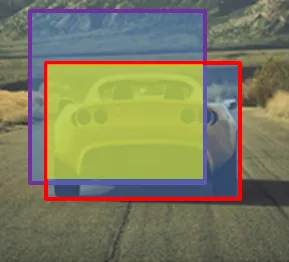在物体检测中,IOU(交并比)是介于0和1之间的值,表示在某个图像中绘制的2个框之间重叠的百分比。
为了帮助您理解这是什么,以下是一个说明:
红色框是具有坐标x1(左上角),y1(左下角),x2(右上角),y2(右下角)的真实值。
紫色框是具有坐标x1_predicted,y1_predicted,x2_predicted,y2_predicted的预测值。
黄色阴影正方形是IOU,如果它的值大于一定阈值(按惯例为0.5),则预测评估为True,否则为False。
以下是计算两个框的IOU的代码:
def get_iou(box_true, box_predicted):
x1, y1, x2, y2 = box_true
x1p, y1p, x2p, y2p = box_predicted
if not all([x2 > x1, y2 > y1, x2p > x1p, y2p > y1p]):
return 0
far_x = np.min([x2, x2p])
near_x = np.max([x1, x1p])
far_y = np.min([y2, y2p])
near_y = np.max([y1, y1p])
inter_area = (far_x - near_x + 1) * (far_y - near_y + 1)
true_box_area = (x2 - x1 + 1) * (y2 - y1 + 1)
pred_box_area = (x2p - x1p + 1) * (y2p - y1p + 1)
iou = inter_area / (true_box_area + pred_box_area - inter_area)
return iou
我有两个csv文件包含预测数据和实际数据,我将它们读入两个pandas DataFrame对象中,并从那里开始。
对于每个图像,我提取特定对象类型(例如:汽车)的检测结果和实际数据,以下是一个示例,描述了一张图像(Beverly_hills1.png)中一个对象(汽车)的情况。
Actual:
Image Path Object Name X_min Y_min X_max Y_max
3842 Beverly_hills1.png Car 760 432 911 550
3843 Beverly_hills1.png Car 612 427 732 526
3844 Beverly_hills1.png Car 462 412 597 526
3845 Beverly_hills1.png Car 371 432 544 568
Detections:
image object_name x1 y1 x2 y2
594 Beverly_hills1.png Car 612 422 737 539
595 Beverly_hills1.png Car 383 414 560 583
这是我的比较方式:
def calculate_overlaps(self, detections, actual):
calculations = []
detection_groups = detections.groupby('image')
actual_groups = actual.groupby('Image Path')
for item1, item2 in zip(actual_groups, detection_groups):
for detected_index, detected_row in item2[1].iterrows():
detected_coordinates = detected_row.values[2: 6]
detected_overlaps = []
coords = []
for actual_index, actual_row in item1[1].iterrows():
actual_coordinates = actual_row.values[4: 8]
detected_overlaps.append((
self.get_iou(actual_coordinates, detected_coordinates)))
coords.append(actual_coordinates)
detected_row['max_iou'] = max(detected_overlaps)
x1, y1, x2, y2 = coords[int(np.argmax(detected_overlaps))]
for match, value in zip([f'{item}_match'
for item in ['x1', 'y1', 'x2', 'y2']],
[x1, y1, x2, y2]):
detected_row[match] = value
calculations.append(detected_row)
return pd.DataFrame(calculations)
每种对象类型都将运行此操作,这是低效的。
最终结果将如下所示:
image object_name x1 ... y1_match x2_match y2_match
594 Beverly_hills1.png Car 612 ... 427 732 526
595 Beverly_hills1.png Car 383 ... 432 544 568
1901 Beverly_hills10.png Car 785 ... 432 940 578
2015 Beverly_hills101.png Car 832 ... 483 1240 579
2708 Beverly_hills103.png Car 376 ... 466 1333 741
... ... ... ... ... ... ... ...
618 Beverly_hills93.png Car 922 ... 406 851 659
625 Beverly_hills93.png Car 1002 ... 406 851 659
1081 Beverly_hills94.png Car 398 ... 426 527 559
1745 Beverly_hills95.png Car 1159 ... 438 470 454
1746 Beverly_hills95.png Car 765 ... 441 772 474
[584 rows x 14 columns]
如何简化/矢量化这个代码,并消除for循环?可以使用
np.where()来完成吗?
total_df的长度比初始预测值大。 - user12690225false_positive = total - true_positive,所以您可以这样做。 - Quang Hoang